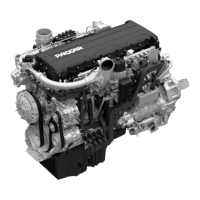PEC017
5/3/2018 Page 46 of 105
engagement communications between the remote PTO module and the cab
electronic control unit (CECU) or via legacy hardwired connection directly from the
PTO device to the engine controller. Remote switch and remote throttle signal types
must be specified within the drivetrain parameters on the CECU. Additional
networking interface parameter changes are required within the CECU depending on
the application requirements in order to allow remote PTO control modules to
function properly via the B-CAN network. For additional information about the
required changes to the CECU parameters, consult the appropriate body builder
manual for the vehicle.
PACCAR MX engines allow for remote engine speed control functionality via TSC1
messaging from remote control modules by configuring Enable Engine Speed
Control via TSC1 (N306). In addition, a hardwired or CAN PTO engagement
feedback signal must be provided to allow the engine to enter PTO mode to enable
PTO engine speed control and safety interlocks, and Signal Source for Remote Main
Switch (N102) must be configured according to the signal source of the PTO mode
request. TSC1 messages must be broadcast from source address 36 (0x24) to
destination address 0 (0x00). Messages must also specify control purpose P3: PTO
Governor to allow the engine controller to respond to TSC1 requests.
The following table describes the J1939 PTO, EEC2 and TSC1 messages supported
by the MX engines while programmed with Remote PTO configurations:
Switch signal of the PTO control
activator which indicates that the
activator is in the position to "set" the
engine PTO governor set speed.
0 = Off
1 = On
2 = Error
3 = Not available
Switch signal of the PTO control
activator which indicates that the
activator is in the position to "resume" a
previously established PTO governor set
speed.
0 = Off
1 = On
2 = Error
3 = Not available

